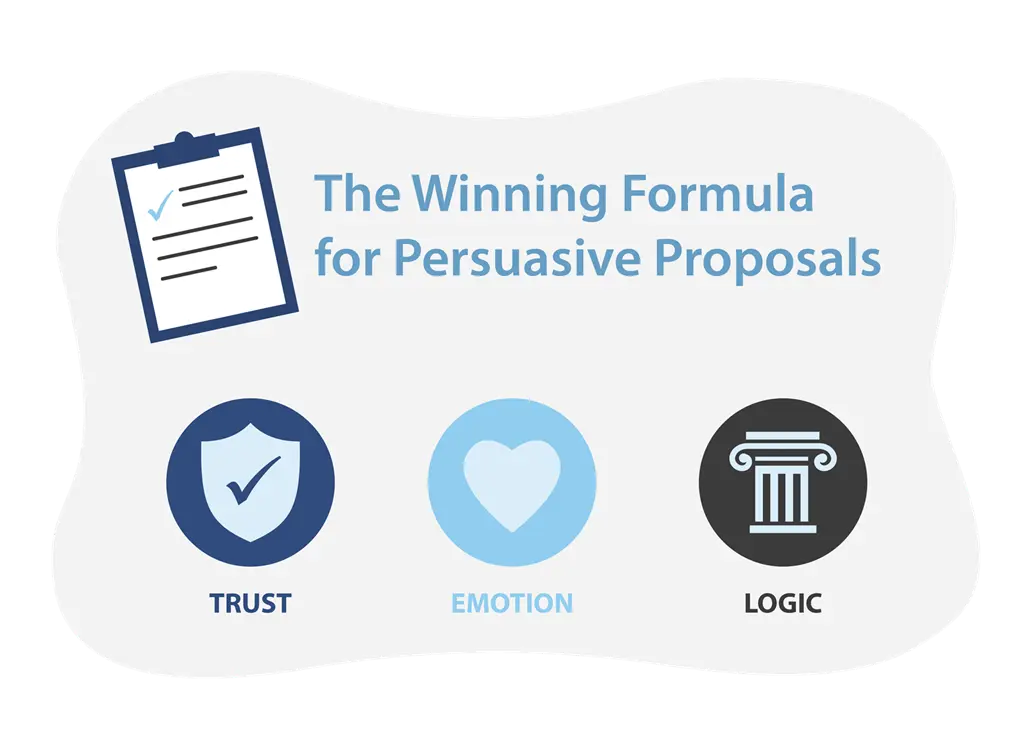Trust, Emotion, Logic: The Winning Formula for Persuasive Proposals

Imagine knowing exactly how to write persuasive RFP responses that outshine the competition. For leaders of small and medium-sized professional services firms, mastering this skill can be the difference between a lost opportunity and a game-changing win. Aristotle’s timeless persuasion framework – ethos, pathos, and logos – holds the key to turning dull proposals into compelling stories that win RFPs.
This post breaks down these three appeals into practical proposal writing tips. Applying these principles will transform your proposals from technical documents into persuasive narratives that stick with evaluators.
Key Takeaways
- Build Credibility (Ethos): Establish trust by showcasing your expertise, track record, and commitment to the client’s success.
- Appeal to Emotions (Pathos): Show you understand the client’s challenges and goals. Craft a narrative that makes them feel heard and excited about your solution.
- Use Logic and Evidence (Logos): Present a clear, logical argument backed by facts, data, and structure — proving your solution makes sense.
- Balance All Three: Persuasive proposals weave ethos, pathos, and logos together. A winning proposal is credible, emotionally resonant, and logically sound.
- Aristotle’s Edge: Using this ancient framework gives you a competitive advantage, helping you craft winning proposals more consistently.
Establishing Credibility with Ethos
Ethos is all about credibility – convincing the evaluator that your firm is trustworthy and competent. In proposal writing, ethos comes through via your tone, content, and presentation quality. To build ethos in your RFP responses, start by highlight the qualifications and experience that matter to the client. Emphasize relevant certifications, industry awards, successful past projects (that are relevant), and testimonials from happy clients. This shows you have a proven track record.
Maintain a professional tone and style as well. Ensure the proposal is well-written and error-free (typos can erode trust quickly!). Match the language to the client’s industry and vocabulary so they feel you “speak their language.” Formatting and design count too: a clean, organized document with a branded look suggests your team pays attention to detail. All these elements quietly signal that you’re credible and capable.
- Showcase Expertise: Open your proposal with a brief narrative of who you are – focusing on your team’s expertise and understanding of the project. For example, mention that you’ve successfully tackled similar challenges before, which sets a confident tone.
- Back Every Claim: Whenever you claim something (“we are leaders in X”), back it up with evidence. Provide data, case study snippets, or client references to prove it. Credibility suffers if bold statements stand alone.
- Professional Presentation: Use clear headings, consistent fonts, and a logical layout. A visually polished proposal implies high standards in your work overall. Small details – even a personalized cover letter – reinforce that you take this RFP seriously.
- Honesty and Clarity: Be transparent about what you can do and avoid exaggeration. If the client spots inconsistencies or fluff, trust is gone. It’s better to clearly outline how you will meet their requirements than to over-promise.
Pro Tip: Have a colleague or mentor review your draft proposal for credibility. An outside eye can spot where your ethos is weak – perhaps an unsupported claim or a section that feels too generic. Strengthen those before submission to ensure you’re putting your most credible foot forward.
Connecting with Emotion through Pathos
Pathos is the art of emotional appeal. In an RFP response, pathos means showing the client you truly understand their pain points and care about their goals. Think about the winning proposals you’ve seen – they often resonate personally, not just at a business level. To use pathos, step into the client’s shoes and consider what worries them and what they hope to achieve. Reflect that understanding in your writing.
Start by echoing the client’s mission or problem statement in empathetic terms. For instance, “We know that reducing downtime is critical for your operations – every minute offline affects your bottom line.” A sentence like this demonstrates you grasp why the project matters emotionally and financially. Use positive, inspiring language to paint a picture of the better future your solution offers: happier customers, less stress, greater success. Storytelling can be powerful here – perhaps include a mini case study of how you helped a similar client overcome a challenge, triggering an “imagine if that were you” feeling.
Emotion isn’t about being sappy; it’s about humanizing your proposal. People ultimately make decisions, not just companies, so forge a connection. Celebrate the client’s values and highlight alignment with your company values (if genuine). Show enthusiasm for the opportunity to partner with them. If the evaluators feel that you “get” them and genuinely want to help, you’ve succeeded in adding pathos to your proposal.
- Client-Centric Opening: Begin your executive summary or introduction by focusing on the client’s situation. Acknowledge their challenges and objectives in a respectful tone. For example, “Your goal of improving community safety while managing tight budgets sets a challenge we’re passionate about solving…” This immediately signals empathy.
- Use Emotionally Charged Language: Sprinkle in words that carry feeling – secure, confident, reliable, innovative, thriving. Describe outcomes in terms of positive impact: e.g., “This solution will give you peace of mind with a reliable system that your team can trust every day.”
- Tell a Success Story: Include a short anecdote of how you helped another client succeed. “When we implemented a similar solution for a healthcare provider last year, they saw a 30% increase in patient satisfaction – and far less stress for their staff.” Stories are memorable and make your proposal more relatable.
- Visualize the Future: Help the client visualize success. Use imagery or metaphors that appeal to their aspirations. “Picture your operations running smoothly even during peak demand – no more frantic troubleshooting at 2 AM. That’s the future we aim to deliver.” Such language makes your offer tangible and exciting.
Pro Tip: Mirror the client’s wording from the RFP in your response. If the RFP mentions a goal like “enhancing stakeholder engagement,” use that phrase and build on it. This not only shows you read and respect their words, but also creates an emotional “echo” – the client sees their own priorities reflected in your proposal.
Making a Convincing Case with Logos
Logos is the appeal to logic and reason. In an RFP context, logos comes down to how clearly and rationally you present your solution. Evaluators need to see a solid business case and know that choosing your firm is a smart, data-backed decision. To strengthen logos in your proposal, organize your content logically and use evidence wherever possible.
First, ensure your proposal has a clear structure that flows naturally – for example, Introduction -> Client Needs -> Proposed Solution -> Benefits/Results -> Pricing -> Conclusion. A logical flow helps the reader follow your argument without getting lost. Guide them step-by-step through your reasoning. Each section should build on the previous one, just like links in a chain, reinforcing why your solution is the right fit.
Next, bring in the facts. Quantify benefits: ROI percentages, time saved, quality improvements, risk reductions – concrete numbers speak loudly. Include relevant data from your past performance (e.g., “99.9% system uptime across five similar projects”) and reference standards or methodologies you follow. If you have visuals like charts or tables, use them to illustrate key points clearly. Ensure a statistic, plan detail, or a logical explanation supports every claim. Avoid vague statements; be specific and direct. Also maintain an objective, no-nonsense tone here, and save any hype for elsewhere.
Finally, the requirements must be addressed point-by-point to show that nothing is overlooked. A checklist or compliance matrix can be helpful to demonstrate that you meet all the RFP criteria logically and fully. When evaluators see a well-structured proposal covering all bases with evidence, it appeals to their logical side – making it easier to justify choosing you.
- Clear Structure: Use headings and subheadings to break down your proposal into logical parts. For example, under “Solution Details,” you might have sub-sections for “Methodology,” “Timeline,” and “Deliverables.” This organization is a subtle yet effective way to lead the evaluator through your reasoning.
- Use Data and Facts: Whenever possible, include numbers or proof. “Our approach will reduce maintenance costs by 15% annually” carries more weight than just saying “significant savings.” If you have statistics or outcomes from past projects, plug them in.
- Answer the Why: Don’t just state what you will do – explain why it’s the best approach. If you propose a particular technology or process, provide a brief rationale (e.g., “This software is proven in your industry, ensuring reliability and user adoption”). It shows you’ve thought things through.
- Pre-empt Questions: Anticipate what the client might be skeptical about and address it head-on. If, for instance, your solution has a higher upfront cost but lower long-term cost, explicitly walk them through that logical trade-off. Don’t leave obvious questions unanswered.
Pro Tip: Use the evaluation criteria as a checklist for logic. If the RFP provides a scoring breakdown or specific questions, structure your responses in that exact order. This makes it ultra-easy for the evaluator to see you’ve logically covered everything – scoring you maximum points for completeness and clarity.
Ready to Win More RFPs?
By now, you’ve seen that writing persuasive RFP responses isn’t a mystery – it’s about applying time-tested principles in a modern context. Aristotle’s framework offers a simple yet powerful set of proposal writing tips that result in credible, engaging, and rational proposals. When you harness ethos, pathos, and logos in your next RFP response, you give your firm a persuasive edge over the competition.
At The Proposal Lab, we specialize in helping professionals like you craft winning proposals using these proven techniques. Whether you need a quick review or start-to-finish proposal support, our team is here to boost your success rate. Contact us today to find out how we can help you write proposals that win – securing more of the right contracts for your business.
